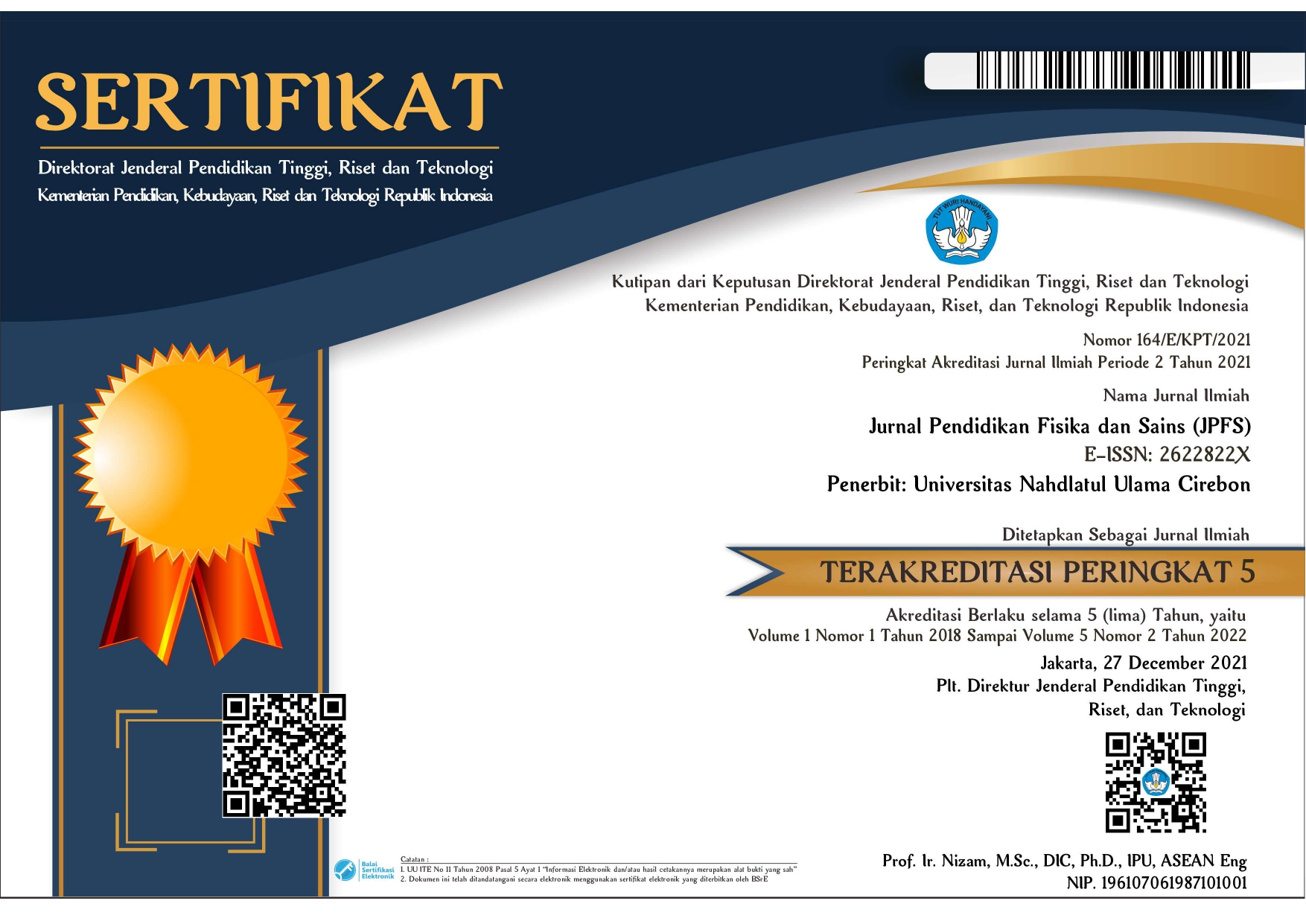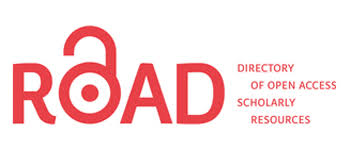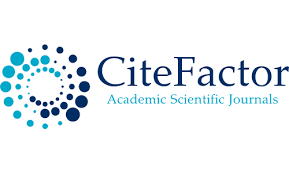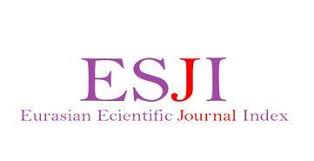Analysis of Project Based Learning Teaching Efficiency in Simple Organ Pipe Practicum
DOI:
https://doi.org/10.52188/jpfs.v7i2.551Keywords:
Organ Resonance, speed of propagation, wave length, resonance tube, sound wavelength, wave propagation speedAbstract
The learning process in physics requires media as illustrations to be able to apply concepts so that they are easier to understand. This method is also useful for an educator to be able to analyze the learning abilities of each student, however, regarding the concepts of vibration, sound waves and frequencies, there are still many errors in understanding and in organ pipe material not many applications of this media have been implemented. so that researchers make media from glass bottles using the project based learning method in implementation with the aim of students being able to understand the concept of vibrations, sound waves and frequencies further, knowing how they work or the principles used and, being able to analyze the factors that influence the speed of wave propagation and frequency. resulting from. From this research, it was found that the wavelengths for each bottle from 1 to 7 were 5.86, 5.07, 4.92, 4.72, 4.30, 3.95 and the resonance frequencies were 58.02, 134.12, 207. .31, 288.13, 375.27, 474.41, 602, 53.
References
Abdullah, Mikrajuddin. 2016. Fisika Dasar 1. Bandung: Institut Teknologi Bandung.
Adegbija, MV & Fakomogbon, MA. (2012). Instructional media in teaching and learning : a Nigerian perspective. Global Media Journal African Edition. 6 (2), 216-230
Agustina, I., Astuti, D.(2016). Pengembangan Alat Eksperimen Cepat Rambat Bunyi Dalam Medium Udara Dengan Menggunakan Metode Time of Flight (TOF) dan Berbantuan Software Audacity UPEJ, 5(3).
Arsyad, Azhar. (2011). Media Pembelajaran. Jakarta: PT. Raja Grafindo Persada
Azalia, A., Ramadhanti, D., Hestiana, H., & Kuswanto, H. (2022). Audacity Software Analysis In Analyzing The Frequency And Character Of The Sound Spectrum. Jurnal Penelitian Pendidikan IPA, 8(1), 177–182
Candra, Riski Ayu, Agung Tri Prasetya, dan Ratni Hartati. 2019. Analisis Kemampuan Berpikir Kreatif Peserta Didik Melalui Penerapan Blended Project-Based Learning. Jurnal Inovasi Pendidikan Kimia. 13(2), 2437 – 2446.
Chasanah, Angga Risnaini Uswatun, Nur Khoiri, Harto Nuroso. 2016. Efektivitas Model Project Based Learning terhadap Keterampilan Proses Sains dan Kemampuan Berpikir Kreatif Siswa pada Pokok Bahasan Kalor Kelas X SMAN 1 Wonosegoro Tahun Pelajaran 2014/2015. Jurnal Penelitian Pembelajaran Fisika. 7(1), 19-24.
Fadhilla, Rahayu Ade,dkk. (2017) Interferensi Gelombang Bunyi Pada Pipa Organa Tertutup. Bandung: ITB.
Fajrina, Rani Nur Arifah Agus, Supriyono Koes Handayanto, dan Arif Hidayat. 2018. Peran Model Project Based Learning dalam Kemampuan Berpikir Kreatif Kelas XI IPA melalui Materi Fluida Statis. Jurnal Pendidikan : Teori, Penelitian, dan Pengembangan. 3(3), 291-295
Farida, N.Melati, P., Ruqoyah, R., Yuristyansyah, V., & Antarnusa, G.(2020). Pengaruh Amplitudo (A), Frekuensi (f), Dan Tegangan Gelombang Pada Tali Berbasis PheT Simulation. Jurnal Untirta. 3(1), 408-414.
Fitriyani, A. O., & Andryani, F. (2023). Analisis Akurasi Penerapan Software Audacity Dalam Menentukan Nilai Frekuensi Pada Praktikum Pipa Organa. Jurnal Inovasi Penelitian Dan Pembelajaran Fisika, 4(1), 24
Giancoli, (2014). Fisika Prinsip dan Aplikasi Edisi ke 7 Jilid 1. Jakarta: Erlangga
Gunawan, Hairunnisyah Sahidu, Ahmad Harjono, dan Ni Made Yeni Suranti. 2017. The Effect Of Project Based Learning With Virtual Media Assistance On Student’s Creativity In Physics. Jurnal Cakrawala. (2), 167-178.
Haisy, Caisar Muhammad, dkk. (2015). Pengembangan Alat Peraga Resonansi Dan Efek Doppler Berbasis Soundcard Pc/Laptop Untuk Meningkatkan Motivasi Belajar Fisika Siswa SMA. Prosiding Vol 4, 9-15
Halliday, R & Walker. (2010). Fisika Dasar Edisi ke 7. Jakarta: Erlangga
Hellesund, S., 2019. Measuring the speed of sound in air using a smartphone and a cardboard tube. Physics Education, 035015(54), pp. 1-5.
Kadri, S., Jaafar, R., Adli, W. Z. & Nazihah, A., 2013. Physics demonstration of sound waves using Visual Analyser. Latin American Journal of Physics Education, 7(1), pp. 10-15.
Khoiril, N, A Marinia, dan W Kurniawan. 2016. Keefektifan Model Pembelajaran PjBL (Project Based Learning) terhadap Kemampuan Kreativitas dan Hasil Belajar Siswa Kelas XI. Jurnal Penelitian Pembelajaran Fisika.7(2), 142-146.
Kua, M.Y., Maing, C.M.M., Tabun, Y.F. et al. (2021). Teori dan Aplikasi Fisika Dasar. Aceh: Yayasan Penerbit Muhammad Zaini.
Lucky Dessitasari, I. S., Matematika, F., Ilmu, D., & Alam, P. (2021). Pengembangan Pipa Organa Menggunakan Aplikasi Physics Toolbox Suite Untuk Menentukan Cepat Rambat Bunyi Di Udara Sebagai Media Pembelajaran Pada Materi Gelombang Bunyi. 10(1), 8–13
Lutfiyah, A. et al., 2017. Correction factors in determining speed of sound among freshmen in undergraduate physics laboratory. Surabaya, Seminar Nasional Fisika (SNF) 2017.
Macho-stadler, E. & Elejalde-garcia, M. J., 2018. Experiments with Kundt’s tube. Bilbao, GIREP-MTPL 2018.
Moldenhauer, J. & Stratmann, K., 2009. Dust Figures in Kundt’s Tube – Investigations on the Formation of Ripples, Oldenburg: Universität Oldenburg, Institut für Physik - Akustik.
Muhafid, d. (2014). Pengembangan Alat Eksperimen Bunyi dengan Sistem Akuisisi Data Berbasis Smartphone Android. Jurnal Fisika Vol 4 (2), 14-18.
Nugraheni, D. 2018. Pembelajaran Berbasis Proyek (Project Based Learning) Materi Kalor dan Perpindahannya untuk Meningkatkan Kreativitas Siswa. Jurnal Penelitian Pembelajaran Fisika. 9(2), 73-79.
Nur Sulistyo, E., 2017. Design and development of multipurpose Kundt’s tube as physics learning media. Yogyakarta, International Conference on Mathematics, Science and Education 2017 (ICMSE2017).
Sari, Wahyu Pramudita, Arif Hidayat, dan Sentot Kusairi. 2019. Keterampilan Berpikir Kreatif Siswa SMA dalam Pembelajaran Project Based Learning (Pjbl) pada Materi Fluida Statis. Jurnal Pendidikan : Teori, Penelitian, dan Pengembangan. 3(6), 751- 757.
Sumarni, L. (2017). Utilizing Audacity Audio-Recording Software To Improve Consecutive And Simultaneous Interpreting Skills. IJIET (International Journal of Indonesian Education and Teaching).1(2), 185-193
Syauqi, dkk. (2018). Pengembangan KIT Tabung Resonansi berbantuan Aplikasi Physics Toolbox Sensor Suite Media Pembelajaran Gelombang Bunyi, Jurnal Inovasi Pendidikan Fisika Vol 7 (2), 325-330
Utami, M. S. N., Arif, N. R. & Yulianto, A., 2014. Pengaruh Frekuensi Resonansi Terhadap Penurunan Suhu Pada SIstem Termo klastik Sederhana. Jurnal Fisika, 4(2), pp. 101-104.
Yanto, I.W.R., Wahyoo, U., & Ali, M.(2015). Pengembangan Media Pembelajaran Menggunakan Seruling Sederhana Berbantuan Software Audacity pada Materi Pipa Organa. Jurnal Pendidikan Fisika Tadulako Online (JPFT). 7 (3) 44-50.
Yustina, W.Syafii, dan R. Vebrianto. 2020. The Effects of Blended Learning and Project Based Learning on Pre-Service Biology Teachers Creative Thinking Through Online Learning In The Covid-19 Pandemic. Indonesian Journal of Science Education. 9(3), 408-420.
Published
How to Cite
Issue
Section
Copyright (c) 2024 Rahma Amelia Oktapiani, Haifina Nuzha Nairiza Hamdie, Febriana Eka Damayanti

This work is licensed under a Creative Commons Attribution 4.0 International License.
Copyright Transfer Agreement
The Authors submitting a manuscript do so on the understanding that if accepted for publication, copyright of the article shall be assigned to Jurnal Pendidikan Fisika dan Sains (JPFS) and Physics Education Programs of UNU Cirebon as publisher of the journal.
Copyright encompasses exclusive rights to reproduce and deliver the article in all form and media, including reprints, photographs, microfilms and any other similar reproductions, as well as translations. The reproduction of any part of this journal, its storage in databases and its transmission by any form or media, such as electronic, electrostatic and mechanical copies, photocopies, recordings, magnetic media, etc. , will be allowed only with a written permission from Jurnal Pendidikan Fisika dan Sains (JPFS) and UNU Cirebon.
Authors are permitted to disseminate published articles by sharing the link/DOI of the article at the journal. Authors are allowed to use their articles for any legal purposes deemed necessary without written permission from the journal with an acknowledgment of initial publication to this journal.
Jurnal Pendidikan Fisika dan Sains (JPFS) and UNU Cirebon and the Editorial Board make every effort to ensure that no wrong or misleading data, opinions or statements be published in the journal. In any way, the contents of the articles and advertisements published in the Jurnal Pendidikan Fisika dan Sains (JPFS) are sole and exclusive responsibility of their respective authors and advertisers.





















